North Twin Lakes
1919

1945

1999

Description:
Plate 48. NORTH TWIN LAKES: 1919 - 1945 - 1999 Grazing was very heavy in 1919 and soil erosion was widespread. The shrubs on the hillside are heavily browsed (high-lined) and active erosion channels are present above the lake. The emergent vegetation around the lake was still heavily grazed in 1945 but active soil erosion had ceased. Sagebrush (Artemisia tridentata) had increased by 1945 and several of the aspen (Populus tremuloides) stands had regenerated. Although sagebrush was still common in 1999, grasses were more abundant than earlier. The lake contained water in 1999, but this was generally hidden from view by a dense growth of riparian vegetation – mainly sedges (Carex spp.) and rushes (Juncus spp.). All of the eroded areas had naturally revegetated by 1999 despite yearly grazing by cattle. Part of the hillside was prescribed burned by the Forest Service sometime in the 1980's. Most of the dark colored low growing shrubs are snowberry (Symphoricarpus sp.), the taller shrubs are serviceberry (Amelanchier alnifolia ) with a small amount of oak brush (Quercus gambelii).
Photo Information:
1919 photo is U.S. Forest Service #468726 taken on Aug. 6; 1945 photo is U.S. Forest Service #468722; 1999 photo is Kay #4446-23, taken on July 24. Forest Service photos held in U.S.F.S. Regional Office Photographic Collection housed at Weber State Univ. Ogden UT.
Vegetative Community:
Wet Meadow, Riparian, Sagebrush, Mountain Brush, Aspen
Location:
South Central: Sargent Mountain, Fishlake N.F, Beaver R.D., T26S, R4½w, Sect. 23, UTM 4265500 N, 384500 E; elevation 8,040 ft., view to southeast.


 Utah 4-H & Youth
Utah 4-H & Youth